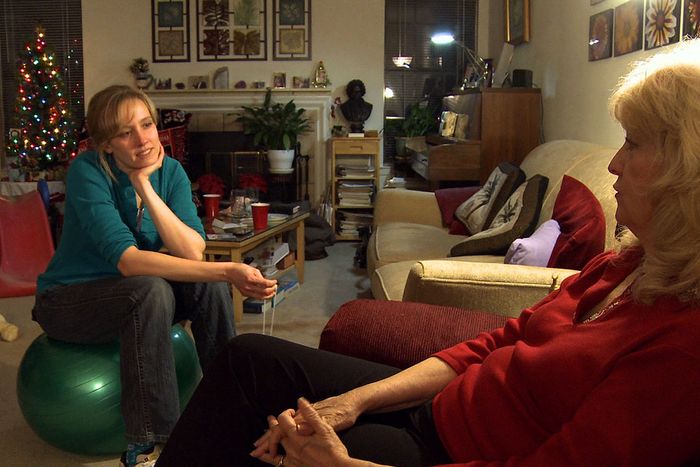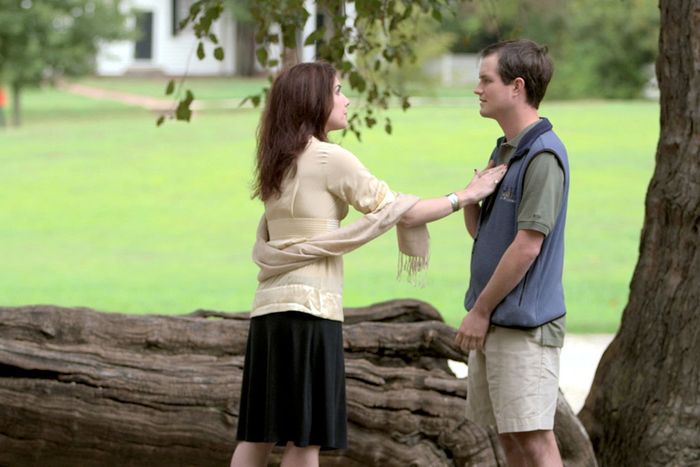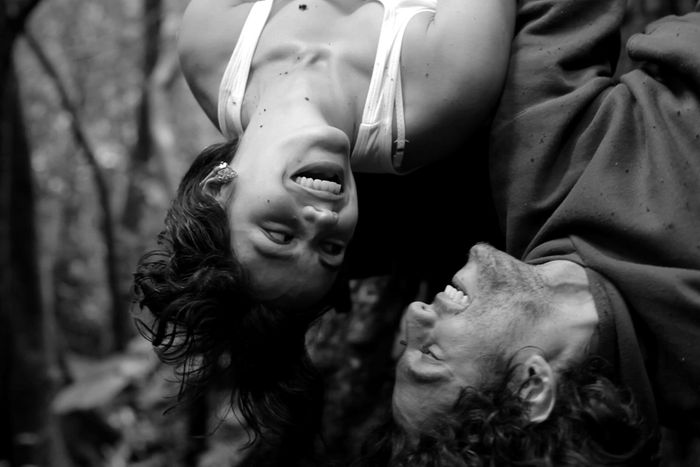Photo: MK2 Pro/Courtesy of Tribeca Film Festival
Since its birth in the early ’00s in the shadow of the fallen Trade Towers, the Tribeca Film Festival has been a proudly mixed-bag, a piñata, if you will, its chief goal to assemble a new and adventurous community of film lovers in downtown Manhattan. Audiences buy passes of various colors and price points, or grab last-minute tickets for films that aren’t — as they are at Lincoln Center’s New York Film Festival — exactingly selected by a tony group of cineastes. You see a lot of half-successful indie films. You see duds. You see movies you’ll never hear about again. And you discover some gems.
The festival has carved out a spot as a showcase for some of the year’s best documentary work, but some of the more exciting films we’ve previewed have been fictional narratives. Loaded with titles from last year’s Venice Film Festival, as well as a number of Sundance hits, this year’s Tribeca titles are heavy on suspense, comedy, and politics.
Even watching films 12 hours a day for — seemingly — weeks, we haven’t made more than a dent in the vast schedule. But we’ve endeavored to list some of our favorites below. That list does not include some very good but not-especially-groundbreaking documentaries (many just too long), on subjects as various as drag racing in Cuba and sons of Nazis coping in various ways with their unholy legacy. We are not un-recommending them, only saying that they would be equally fine watching on TV. The best festival films must have a sense of occasion.
The concept of Christian courtship — which forbids dating, or even kissing, in favor of a more traditional process, akin to arranged marriages — seems simple enough on the surface, but as this documentary shows us, it’s anything but. Following one particularly devout family and a young woman who, after years of living with them, is now 33 and still unwed, director Amy Kohn demonstrates sensitivity and acuity as she reveals the nuances of this unique (and, for many of us, jaw-dropping) approach to modern romance.
Mickey Rourke, with his ruined, bloated visage, is the mortally ill CIA assassin who lives next door to disaffected teenager Nat Wolff, who presses the older man to learn something about the many people he has iced — on orders from his bosses — over the years. Tony McNamara’s film is a very peculiar mix of coming-of-age comedy and vigilante violence, with flaky turns by Sarah Silverman as Wolff’s rather desperate single mom and Emma Roberts as the sexy-nerdy girlfriend who happens to have a brain-scanner in her basement. What makes it play are the weird rhythms of Wolff and especially Rourke — whose presence is too disturbing for comedy.
Photo: Peter Taylor
704-502-4888
www.ptpix.com
[email protected]
With uncommon access, this gripping documentary about the notorious Red Mosque — a religious organization that runs a network of jihadist madrassas in Pakistan — reveals how those preaching zealotry, intolerance, and repression can insinuate themselves into desperately poor, hungry communities. The kids entering these schools are a mixed bag of the idealistic, the desperate, and the fresh-faced, and we see how they can be transformed into vessels of hate.
In this brief doc, Matt Fuller introduces four young adults on the autism spectrum who attempt to reconcile their longing for romance and companionship with a condition that makes empathy difficult. Fuller’s central couple is so attractive and functional that they often appear to be “normal” (a loaded and inexact term, I know, but useful when talking about the spectrum), but they still face hurdles getting in synch. One man — his affect recalls Raymond in Rain Man — loses his wife to cancer and remains poignantly impenetrable. (He says he can’t love her anymore because she’s gone.) Another is angrily, desperately unhappy in his loneliness. I wish the film had more breadth to go with its intimacy, but the light it shines is compassionate and moving.
An affluent, existentially dislocated yoga instructor (Jessica Biel) seeks out her biological half-sister — who turns out to be a dirt-poor prostitute named Shiva (Zosia Mamet) with a violently unhinged but rather eloquent boyfriend-pimp (Joe Anderson). Diane Bell’s film is another indie drama that straddles genres before settling into something more formulaic, but she takes a lot of chances with Shiva, whose emotional zigs and zags are on the border between piteous and exasperating. Mamet’s very modern mix of spikiness and vagueness puts it over.
A rambling, amusing, stranger-than-fiction doc about an incredibly bitter loner who’s cast as a giant banana to perform in Seattle’s campy semi-pro wrestling scene — and then becomes incensed when organizers (dismayed when he turns the Banana into a villain) create a comic “Second Banana.” So he rats out the scene to a regulatory commission. Directors
Ryan Harvie and
John Paul Horstmann love their misfits, and so — within reason — will you.
Matthew Heineman’s troubling documentary, another Sundance hit, about vigilante groups on both sides of the border in the porous region between Mexico and the Southwestern U.S. — an area increasingly taken over by drug cartels — is explosive stuff, to be sure. The director’s access has ensured that we get scenes of startling, real-life violence and hair-raising suspense. Many will argue that the film doesn’t thoroughly explore all the political nuances of this issue. But nuance isn’t part of the game here: Heineman wants to thrill us and shock us into awareness. In that, he succeeds marvelously.
Douglas Tirola’s sweeping documentary about the infamous, controversial humor magazine is one of numerous events at Tribeca this year around the world of humor (the festival’s opening-night film is a Saturday Night Live doc, after all, and one of its other centerpieces is a Monty Python appearance). Tirola’s fast-paced, informative film is a study both of the magazine’s legacy as well as the oddball cast of characters who inhabited its offices. But it’s also, subtly, a dig at today’s more sensitive times: It becomes very clear, as you watch the film, that a magazine like the Lampoon, along with everything it helped give rise to (including, yes, SNL), just couldn’t survive in today’s age of social media and instant offense.
Viggo Mortensen plays a French schoolteacher in the Algerian countryside in 1964 who has to transport a local prisoner (Reda Kateb) as civil war and revolution break out around them. Mortensen’s dialogue is mostly in French and Arabic (which might make this an interesting companion piece to Jauja, another cosmic road movie in which the multilingual actor has to speak two different languages), and he has rarely been better, as these two very different men come to a closer understanding against a beautiful, rugged landscape torn apart by violence.
Ethan Hawke reunites with his Gattaca director Andrew Niccol for a war movie unlike any other. As a drone pilot who works out of a trailer in a stretch of desert near Las Vegas, Hawke’s character experiences combat through the unreal filter of technology: He has godlike power over all he surveys (and obliterates), yet has no connection to the human suffering and carnage on the ground. As a writer and director, Niccol has always been interested in the alienating power of tech, but he also understands drama: Even as the film directly tackles the philosophical and mental ramifications of war fought by remote, it also delivers scenes of heart-stopping tension, as Hawke and his crew sit behind screens trying to decide who lives and who dies.
Photo: Voltage Pictures
In León, Mexico, the most-gored bullfighter in Spain prepares for one last bout as his family worries over his fate. Ido Mizrahy’s melancholy, effective documentary is as much a domestic portrait as it is a movie about bullfighting, as it reflects on the conflict between a man’s dreams of glory and his duty to his loved ones.
One of the craziest films at this year’s Tribeca Fest, Saverio Costanzo’s film starts off with a hilarious, gross meet-cute between Adam Driver and Alba Rohrwacher in a New York restaurant’s malfunctioning bathroom, then proceeds into way, way darker territory — as they become a couple, get pregnant, get married, and then attempt to raise a newborn in a world of perceived dangers. Soon, the film goes from moody romance to expressionistic domestic thriller, but always with an unnerving focus on the corporeal — as if Blue Valentine had been hijacked by Todd Haynes’s Safe, or Polanski’s Repulsion. Driver does some of the best work of his young career, playing a man trying to juggle his increasingly at-odds roles of husband, father, and son. Meanwhile, Rohrwacher is riveting as a mother whose sanity and worldview are constantly being questioned. Be warned: This disturbing film’s even more disturbing ending will prompt much debate.
Yankees broadcaster John Sterling shills for it during games. Industry commercials call its energy “clean, safe, too cheap to meter.” Ivy Meeropol’s portrait of the aging Indian Point nuclear power plant — a cloud from which could conceivably drift over the Tribeca Film Festival — mixes interviews with confident, gung-ho workers and glimpses of life (or the lack thereof) in Fukushima, Japan. The film’s core — so to speak — turns out to be the former Nuclear Regulatory Commission chairman Gregory Jaczko, a generally industry-friendly guy who had the audacity to speak mildly about improving safety to forestall catastrophic accidents and was prodigiously slimed and driven out by corporate kingpins. See it if you want to lose sleep.
Building on the grim statistic that a majority of African-Americans are raised in single-parent homes, Ricki Stern and Anne Sundberg follow Grammy Award–winning rapper Che “Rhymefest” Smith as he tracks down the dad he has barely met — who turns out to be a homeless, effusive but resolute alcoholic. Buying his father’s old house and raising a family in it is a potent symbolic gesture, but the doc leaves you very sad.
Stories in which a young boy has to deal with a neighborhood bully are a dime a dozen, but this exceptionally taut, well-acted drama achieves a compelling mixture of dreaminess and grit. It also captures the strange, surreally urgent quality of adolescence, where even the smallest action feels like it can have world-ending consequences. It’s a weird tonal mix — a coming-of-age movie that constantly seems on the verge of turning into a horror film — but director Felix Thomson and his young cast navigate it well.
Sibs Shongwe-La Mer’s debut is an artily pretentious — and brave and powerful — South African version of last year’s ultranaturalistic teen-angst drama Palo Alto. The black-and-white film opens with a teenage girl who livestreams her own suicide by hanging, then shifts to the seemingly random escapades and couplings of friends and acquaintances (black, white, Afrikaans), along with an occasional interview conducted by a documentary filmmaker exploring the girl’s death. Some of the dialogues have a stilted, groping-for-words quality, and occasional intertitles add little but graphic punch. The ending is a mistake. But the multiracial tensions aren’t overplayed, and the suicide colors everything while rarely being invoked. The searching, suggestive technique holds you.
It might be hard for many in the West to believe, but once upon a time, Pakistan had a thriving, secular artistic culture —long before it was consumed by military conflict, religious intolerance, and Cold War gamesmanship. This documentary follows a group of classical musicians who once thrived in the Pakistani film industry and elsewhere as they struggle to find a place for themselves in a society where artists must still fear for their lives. But then, thanks to their unlikely take on jazz standards, these men discover an appetite for their music in the U.S. — and what was a dire look at a country in cultural free-fall becomes something surprisingly magical and hopeful.
A taut, shockingly brutal postapocalyptic drama of few words, the Irish writer-director Steven Fingleton’s debut feature makes The Road look like a Hope-Crosby comedy. Martin McCann is the emaciated title character who watches over a small garden by his shack in the woods with shotgun at the ready, all softness and trust burned away. I can’t imagine I’ll ever forget the first sight of the actress Olwen Fouéré, who appears outside his front door — gazing at him in stillness like a white-haired wraith — and offers the barely pubescent body of her daughter (Mia Goth) in return for shelter and food. We do not know the raiders who show up to plunder and kill — only that they’ve been reduced to their most primal instincts. But we understand that the barbarism feels, on some ghastly evolutionary level, right.
Photo: The Fyzz Facility Film One Limited 2014
Lyric Cabral and David Felix Sutcliffe’s extremely revealing documentary, which also won an award at Sundance, is as much a remarkable act of patience as it is a cinematic achievement. The film charts the years-long attempt by an FBI informant in the Muslim community to bring down a suspected domestic terrorist. But the filmmakers also follow the suspect himself — and something dramatically different emerges. However, the film is not just about a colossal investigative screw-up; it’s a very human, complex look at how individuals in marginalized communities have been affected by 9/11 and the war on terrorism.
Nick Berardini’s doc could hardly be more timely or essential. It begins as a portrait of the phenomenally successful Taser International, and its owners Rick Smith and his brother Thomas, whose company maintains that its electroshock weapons (with its electrode darts) save countless lives every year: It’s the real-world version of Star Trek’s “Phasers on stun.” After a tour of the factory and a breezy recounting of the weapon’s genesis (creator Jack Cover, a NASA researcher, was inspired by the adventure novels of Tom Swift), Berardini shifts to excruciating stories of people (some of them mentally ill and juvenile) who’ve been tased multiple times and gone into cardiac arrest — which the company maintains (in all seriousness) (really) (I’m not exaggerating) is pure coincidence. The thing you take away is that cops who might have otherwise used their, you know, drawn guns (unfired) or bodies to apprehend suspects just love using these things. But no one on Star Trek died from “phasers on stun.”
Paz Fabrega’s gorgeous, fleeting, almost stream-of-conscious black-and-white love story from Costa Rica opens with 30-year-old Pedro (Fernando Bolanos) trying to plant a drunken kiss on a pretty stranger, 29-year-old Luciana (Kattia Gonzalez), at a costume party. She pushes him away in shock, walks downstairs while he uses the bathroom, then comes back up the stairs (it’s one long shot) and finishes the kiss. Luciana doesn’t go home; she accompanies Pedro (an archeologist) to Rincón de la Vieja Volcano National Park. During their snuggling and sex, she’s always laughing, laughing, reveling in the innocence and spontaneity; he’s increasingly smitten — and taking a long view that she might not share. At 70 minutes, this leaves you — like Pedro — wanting more, in the best way.
The winner of the Documentary Grand Jury Prize at Sundance this year, Crystal Moselle’s film delves into the lives of six Lower East Side brothers whose parents have kept them sheltered from the outside world in a tiny apartment. But instead of a depressing film about isolation, poverty, and neglect, this is one about movie love: These kids relate to the outside world by making elaborate, homemade re-creations of their favorite movies. And slowly but surely, their curiosity about the city outside their windows becomes overwhelming. Some will feel that Moselle doesn’t fully engage some of the darker issues at play here — after all, what’s happened to these kids could be considered abuse — but this is, in the end, a fascinating film about a fascinating family, and it’s very hard to shake.
Photo: Courtesy of Sundance Institute
The legendary Taviani Brothers — two of Italy’s greatest filmmakers — create fables that start simple but gather political and psychological force as they proceed. In other words, they’re a perfect match to adapt Giovanni Boccaccio’s legendary The Decameron. (One might even wonder what took them so long.) But in their take on these classic tales, the Tavianis are less interested in bawdiness and irony, and more in pitting individual creativity and love against mob rule, panic, and repression. But their cinema remains very physical — the way characters move in their films often says so much, and in translating (and reinventing) Boccaccio’s stories, they seem to have created something that borders on dance. Don’t miss this.
Photo: MONTIROLI

























